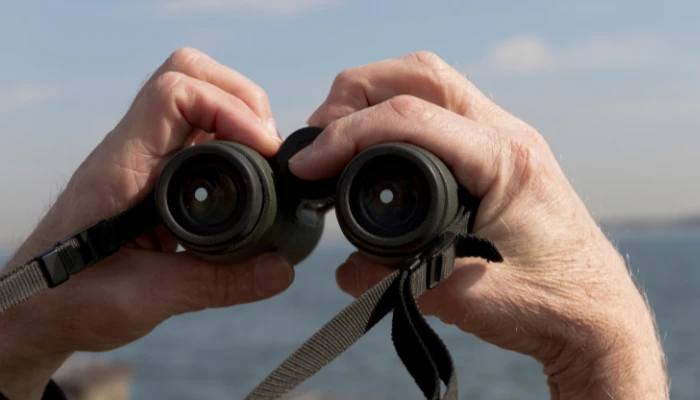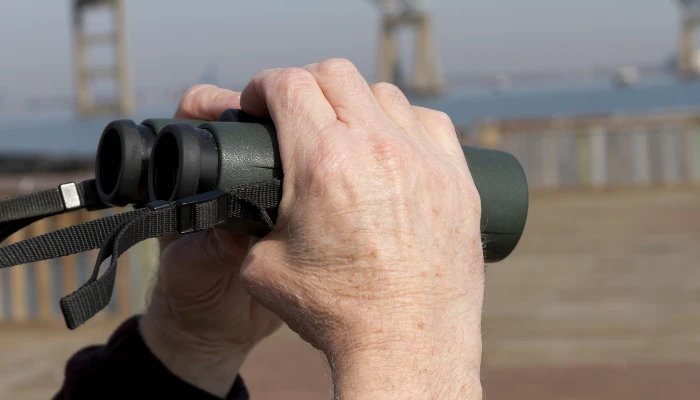This post may contain affiliate links which means I may receive a small commission for purchases made through the links. Learn More
Binos have become common tools and they are widely used by birdwatchers, hunters, hikers, and outdoor enthusiasts to get a closer look at things that are far away. However, many people do not know how binoculars work and what key parts play a role in giving you magnified visuals. If you are also one of them, don’t worry as this guide has got you covered.
So, how do binoculars work? They work by using two objective lenses and two eyepieces to magnify the image of a distant object. The objective lenses gather light and focus it onto an image plane, while the eyepieces magnify the image and present it to the user’s eyes. Prisms also play their role in making the image right-side up and correcting for any color distortion.
This was the brief answer for those people who are in a hurry. However, I highly recommend you to read this guide completely as a lot more interesting information is coming on your way. Without any more delay, let’s get started.
Related Article: Can Binoculars Be Pawned?
Easy Explanation: How Do Binoculars Work?
So, let’s get into the depth. Look, binoculars are optical devices that use two telescopes mounted side by side to magnify distant objects and make them appear closer. For working, binoculars depend on many optical components or parts that play their role.
There are three main components including, the prism system, objective lens, and eyepiece which control the basics or mechanism of binoculars’. In the section below, I will go into detail about each part and explain how each component plays its role in the working of binoculars.
1- Prism System
The prism system is what makes binoculars work. It won’t be wrong if I say that prism are the main or central part of the binoculars.
Don’t you know what prisms actually are? Prisms rotate the image through 180 degrees. One prism rotates the image through 90 degrees, flipping it onto its side, then the next prism rotates it through another 90 degrees, flipping it onto its side again, so the two prisms effectively turn it upside down.
But the question might come into your mind why their flipping of the image is done? Actually, the visual that reaches into the binoculars for processing is actually get down dimension. So, prims process the visuals and allow the user to see an upright image.
Note: Without prisms, you would see an inverted image which won’t give you a perfect viewing experience.
2- Objective Lens
Another important part of binoculars is the objective lens. If this lens doesn’t work properly, then you won’t be able to see through them.
The objective lens is the lens at the front of the binoculars. It gathers light and focuses it onto an image plane. The larger the objective lens, the more light it can gather, which means that the image will be brighter and clearer.
When you use binoculars, these lenses capture the light that is reflected back from the targeted object and help you see the visual through a barrel of binos.
3- Eyepiece
The eyepiece is the lens at the back of the binoculars. I think it is confusing when I say that the eyepiece is present at the back end. Look, this eyepiece or ocular lens is present on the side which is nearest to your eyes when you use the binoculars.
Let’s not go into the debate front to back as it can be confusing for you. It magnifies the image and presents it to the user’s eyes. Lenses with different magnification powers are used in different binoculars.
Let me explain the eyepiece with a simple example. If your binoculars have 10x magnification then it means that the eyepiece has a magnification power of 10x It means that the image will appear ten times closer than it would to the naked eye.
4- Diopter Adjustment
With binoculars in your hands, you can manually adjust the focus. Do you know how this happens? It is due to a diopter. Suppose you have one eye very strong while another eye is weak then you can adjust the focus in a way that you strong will be able to see everything clearly.
The diopter adjustment is a feature that allows the user to adjust the focus of each eyepiece separately. The diopter adjustment is usually located on one of the eyepieces and can be adjusted by rotating it.
Summary of working of Binoculars:
- First of all objective lenses capture the light from the surrounding, especially the light which is reflected back from the target.
- The prism present inside the body of the Binoculars corrects the angle of the image. Keep in mind that the visual or light that goes to the prism is upside down. Prism rotates this visual to 180° and corrects its dimension.
- The eyepiece is located at one end of the binoculars (which is nearest to the user when he sees through the binoculars). This lens magnifies the size of the image of the target.
- If you have different eyes strength then diopter adjustment is also an important feature that allows you to adjust the focus according to your needs.
Binoculars Parts & their Functions

In the above section, I have thoroughly discussed how binoculars work and the whole process with each component involved. However, I am not stopping my finger to stop typing as I am going to discuss the binoculars’ key parts that most people don’t know.
Here is the list of binocular parts
- Objective lens
- Prisms
- Ocular Lens
- Focus Wheel
- Diopter
The objective lens, eyepiece, and diopter have already been explained in the above section. I hope that you’ve already got some information about them. I don’t need to repeat them in again in this section. Let’s talk about the remaining components that you might have not known yet.
1- Prism System
Binoculars use prisms to invert and correct the image orientation. There are located inside the body of binoculars. As I said earlier, there are two types of prism, and their names are listed below:
- Porro Prism
- Roof Prism
There are two types of prisms commonly used in binoculars. Let me tell you the difference between them.
Porro prisms are the traditional style and are characterized by their offset eyepieces. Roof prisms are more compact and have a straight-through design but their prices of roof prism is too high. Binos that consist of roof prism are usually very expensive.
Also Read: Most Common Problems with Swarovski Binoculars
2- Focus Wheel
Almost every modern binoculars consist of a small knob which is called a focus wheel. The focus wheel is used to adjust the focus of the binoculars. This small knob works by moving the objective lens back and forth to bring the image into focus.
The focus wheel is usually located in between two-barrel or tubes of the binoculars. In fact, the knob is positioned in such a way that your index finger reaches it with ease. When you will hold binoculars, your index finger will automatically fit on it.
3- Barrel bridge with Hinge
The barrel bridge with hinge is part of the binoculars that connect the two telescopes. It allows the viewer to adjust the distance between the eyepieces to match the width of their eyes.
With the help of this barrel bride, two-barrel or telescopes remains connected and the interior components don’t get misaligned when your binos fall off your hands. Mostly, this part is made of rubber material. However, it is made to bear the shocks and falls.
4- Anti-reflective Coating
In the previous guide, I always mention that you should choose binoculars that have a coating on their lenses. The coating present on the lenses play a very important role in the performance and usability of your binoculars and anti-reflective coating is one most prominent type of coating.
Don’t you know what is an anti-reflective coating? It is a thin layer of material that is applied to the lenses to reduce glare and improve image clarity. It is particularly useful when viewing objects in bright sunlight or other high-glare conditions.
The coating present on the lenses also helps in transmitting maximum light. So, when you use binoculars that have the coating in low light conditions, these binoculars then transmit maximum light and help you everything clearly, and offer brighter and shaper visuals.
How do prisms of binoculars work?
During research for writing this guide, I saw many people asking about the prism of binoculars. They had no information about how the prism of binoculars works. If you are one of them, don’t worry as I have got your back.
Before I go into explaining the working of the prism, let’s give you an overview and functionality of the prism used in binoculars.
What is the function of the prism? They are used to correct the image orientation and obtain an upright image. Prisms serve two main functions in binoculars: first, they flip the image right side up, and second, they correct the inverted image.
Consider Reading: How to Repair Binoculars at Home?
1- Path of Light in Prism Binoculars
The path of light in prism binoculars is different from that of simple lens binoculars. In prism binoculars, the objective lens collects the light, which then passes through the prism system. The prism system rotates the image by 180 degrees and sends it to the eyepiece lens. The eyepiece lens magnifies the image and presents it to the viewer. You might be thinking about how the prism inverts the images. Don’t worry, this is going to be discussed in the upcoming section.
2- How do Prisms Invert the Image?
The image generated by the objective lens is usually upside down and sometimes even backward. This is where the role of the prism starts. They invert the image by 180 degrees and then send the image to the eyepiece as said earlier.
Keep in mind that each prism can rotate light by an angle of 90 degrees. A set of two prisms in each tube is used to obtain the desired image in a pair of binoculars.
3- How does the Image Get into Focus?
After the image is flipped and rotated by the prisms, it is sent to the eyepiece lens. The eyepiece lens magnifies the image. The user keeps eyes on the eyepiece which is also called the ocular lens and sees the image send by the prism.
To get the image into focus, the viewer adjusts the focus knob. The focus knob moves the eyepiece lens forward or backward, which changes the distance between the eyepiece lens and the prism system. This changes the focal length and brings the image into focus.
Frequently Asked Questions
Binoculars use two types of lenses: objective lenses and eyepiece lenses. The objective lens is the larger lens at the front of the binoculars and is responsible for gathering light from the object being viewed. The eyepiece lens is the smaller lens at the back of the binoculars and is responsible for magnifying the image created by the objective lens.
Binoculars work on the principles of optics, specifically the principles of lenses and light. The objective lens collects light from the object being viewed and forms an image. This image is then magnified by the eyepiece lens, which allows the viewer to see the object in greater detail.
Binoculars can work at night, but they require additional features to do so effectively. You will need night vision binoculars that use infrared rays to give you brighter visual at night. General binoculars don’t work at night.
Conclusion
In the past, there were only a few options for binoculars. But things have changed, and you’ll see a difference with a variety of premium features like image stabilization, and rangefinding capabilities. However, the working of all types of binoculars is the same which I have explained in the above guide. I hope that this comprehensive guide will be helpful to you.

Miqdad is a passionate outdoor adventurer and an expert in optics. He holds degrees in the field and his love for exploring nature up close with binoculars has driven him to research and deepen his knowledge of optics. All the content present on this website is written by Miqdad as he is a proficient writer as well.

